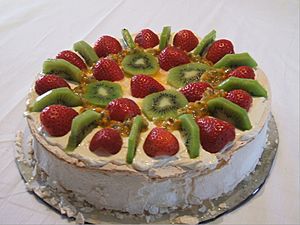Pavlova (food) facts for kids

A Pavlova typically garnished with strawberries, passionfruit, kiwifruit and cream
|
|
| Course | Dessert |
|---|---|
| Region or state | Australia and New Zealand |
| Main ingredients | Egg whites, caster sugar, fruit |
Pavlova is a delicious dessert made mostly from meringue. It's named after a famous Russian ballerina named Anna Pavlova. This sweet treat has a crunchy outside and a soft, light inside, like a marshmallow. People usually top it with fresh fruit and whipped cream.
Many people believe this dessert was created to honor Anna Pavlova. This happened during or after her dance tours in Australia and New Zealand in the 1920s. For many years, Australia and New Zealand have debated which country invented it first.
Pavlova is a very popular dish in both Australia and New Zealand. It's an important part of their national food culture. Because it's fairly simple to make, it's often served during celebrations and holidays. It's especially popular in the summer, including at Christmas time. However, families in Australia and New Zealand enjoy it all year round.
Contents
Where Did Pavlova Come From?

The exact origin of the pavlova is a bit of a mystery! Many people from Australia and New Zealand claim their country invented it.
One story says that a hotel chef in Wellington, New Zealand, created the dish. This happened when Anna Pavlova visited there in 1926.
Professor Helen Leach, who studies food history in New Zealand, has collected many pavlova recipes. She found that an early version of the recipe was published in a New Zealand magazine in 1929. She also noted that the first Australian pavlova recipe appeared in 1935.
Some people claim that Bert Sachse created the dish in Perth, Western Australia in 1935. However, finding a clear answer about the pavlova's true beginning is hard. Many experts say that desserts with meringue and cream have been made for a long time. It's unlikely that Australia or New Zealand were the very first to combine them.
Interestingly, the first recipe actually called "pavlova" was published in Australia in 1926. But this early "pavlova" was not a meringue dessert. It was a colorful gelatine dish!
Some research suggests that the modern pavlova might have come from Germany. It may have started as a German torte. Then, it traveled to America and developed into the form we know today.
How to Make and Eat Pavlova

Making pavlova starts with beating egg whites until they are very stiff. Then, you slowly add caster sugar. After that, you gently mix in vinegar or another acid, like cream of tartar. You also add cornflour and sometimes vanilla essence. This mixture is then baked slowly, similar to how you make a regular meringue.
What makes pavlova special is its texture. It has a crisp, crunchy outer shell. But inside, it's soft and moist, like a marshmallow. This is different from a regular meringue, which is usually solid all the way through. Many believe the cornflour helps create this soft, marshmallowy center.
Pavlovas are quite delicate and can deflate if they get cold air too quickly. So, after baking, they are usually left in the oven to cool down completely. This helps them keep their shape.
Traditionally, pavlova is decorated with a generous topping of whipped cream. Then, fresh, soft fruit is added. Popular choices include kiwifruit, passionfruit, and strawberries. You can also buy ready-made pavlova shells at supermarkets. This makes it easy to decorate them at home.
If you have leftover decorated pavlova, you can keep it in the fridge overnight. However, it might lose some of its crispness as it absorbs moisture. An undecorated pavlova shell can be stored for several days in an airtight container. You can then decorate it when you're ready to serve.
In Australia and New Zealand, Christmas happens during the summer. So, "The Pav" (a short name for Pavlova) is a very popular dessert for Christmas Day. It's often served chilled from the refrigerator.
Pavlova in Culture
World's Largest Pavlova
New Zealand has celebrated the pavlova by making some huge versions! In February 1999, Te Papa, New Zealand's national museum, made the world's largest pavlova. It was called "Pavzilla" and was 45 meters long. The Prime Minister at the time, Jenny Shipley, even helped cut it!
This record was broken in March 2005 by students in Hawke's Bay, New Zealand. Their creation, named 'Pavkong', was an amazing 64 meters long!
In August 2010, a chef named Aaron Campbell made a giant 50-square-meter pavlova. It was shaped like a rugby field with the Bledisloe Cup in the middle. This huge dessert was displayed in the ChristChurch Cathedral to raise money for a charity.
NZI Advertising Campaign
In 2007, an insurance company called NZI created some funny TV ads in New Zealand. These ads playfully showed things that New Zealanders consider their own being "adopted" by other places. The pavlova was featured in these ads. This highlighted the friendly competition between Australia and New Zealand over who invented the dessert.
Images for kids
-
A store-bought New Zealand pavlova decorated with wine gums, strawberries and cream. The soft marshmallow-like centre is visible.
See also
 In Spanish: Tarta pavlova para niños
In Spanish: Tarta pavlova para niños



